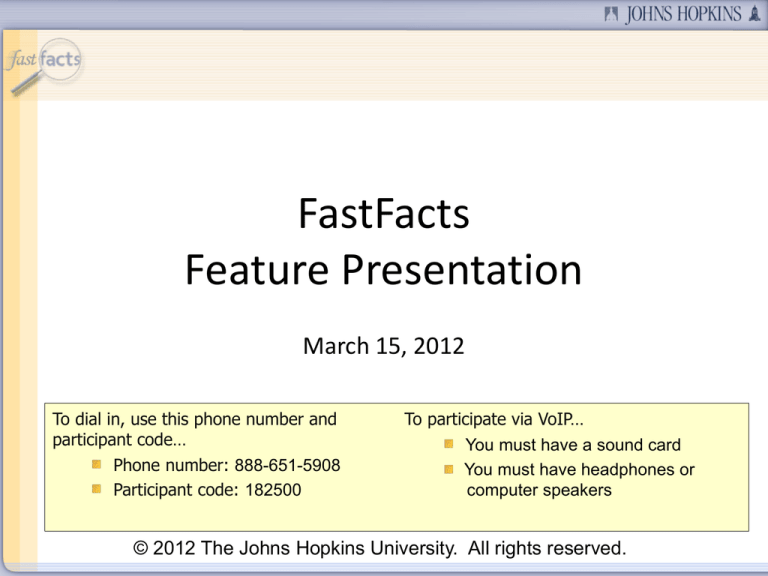
FastFacts
Feature Presentation
March 15, 2012
To dial in, use this phone number and
participant code…
Phone number: 888-651-5908
Participant code: 182500
To participate via VoIP…
You must have a sound card
You must have headphones or
computer speakers
© 2012 The Johns Hopkins University. All rights reserved.
Today’s Topic
• We’ll be taking a look at…
Promoting Social and Behavioral
Competencies for Parents: Protecting your
Child from Bullying
Today’s Presenter
• Anne Townsend, Ph.D.
Chief Academic Officer for Mariposa Child Success Programs
Session Segments
• Presentation
– Anne will discuss bullying, teasing and social exclusion.
– During Anne’s presentation, your phone will be muted.
• Q&A
– After the presentation, we’ll hold a Q&A session.
– We’ll open up the phone lines, and you’ll be able to ask
questions.
– Anne will answer as many of your questions as time
allows.
Contact Us
• If you would like to submit a question during the presentation
or if you’re having technical difficulties, you can email us at:
fastfacts@jhu.edu
• You can also send us an instant message!
– GoogleTalk – HopkinsFastFacts@gmail.com
– AOL Instant Messenger – HopkinsFastFacts
– MSN – FastFacts@jhu.edu
How To View Full Screen
Survey
• Survey
– At the end of this FastFacts session, we’ll ask you to
complete a short survey.
– Your honest comments will help us to enhance and
improve future FastFacts sessions.
Mariposa Child Success Programs
Bullying, Teasing and Social Exclusion
March 15, 2012
Copyright © 2009, 2010, 2011 Dr. Anne Townsend
Mariposa Child Success Programs
Mission and Method
Mission: to foster
social-emotional
competence
in children by training
adults in five key skills.
The Mariposa Method:
Empathy
Personal Message
Cooperative Problem Solving
Descriptive Reinforcement
Inductive Discipline
What Is
Social-Emotional Competence?
Understanding
feelings
Developing healthy
relationships
Managing emotions
Problem solving
Behaving responsibly
Why
Social-Emotional Competence?
Reduces challenging behaviors
Boosts academic performance
Increases a child’s resiliency
Learning Objectives
1
Bullying:
What it is and what it is not
2
Why it happens:
Contributing factors
3
How adults can help:
Insights & options for
problem solving
Bullying
Poll
What characteristics
constitute bullying
behaviors?
Bullying Characteristics
1. Deliberate
2. Imbalance of power
3. Repeated
Physical
Bullying
Poll
1. Physical
2. Verbal
3. Psychological
Psychological Aggression
Bullying
Social
Poll
Relational
Indirect
• Yes
• No
• Not sure
Bullying
Poll
Bullying
Poll
Do you think
that
Do
youbullying
think thathas
bullying has
increased
in the
increased in the
past
decade?
past decade?
Bullying
It is hard to know…
Poll
• Bullying is under reported by kids
(Culture of silence)
• Bullying is under recognized by adults
(Indirect aggression is difficult to identify)
•Bullying is part of growing up
• Only children who are different get
bullied
Bullying
Poll
•Victims need to fight back
• Tattling is bad
•Bullies suffer low self-esteem
•Bullying is the result of a root cause
True or
false?
Bullying
Poll
Bullying
Why Does
Happen?
CHILD
CHILD
Family Factors
that Contribute to
The Problem
Lack of warmth and
involvement
Harsh discipline
Overly permissive parenting
Lack of supervision
CHILD
Community
School Factors
that Contribute to
the Problem
Zero tolerance
Focusing on bullies and
victims
Group punishment
Lack of awareness
CHILD
CHILD
Community
Child Factors
CHILD
CHILD
Children who bully:
Lack empathy for others
Are impulsive and aggressive
Desire to dominate
Have a positive view of violence
May have inflated self-esteem
Community
Child Factors
CHILD
CHILD
Victims of bullying:
Tend to be either passive or
provocative
Often are socially isolated
Exhibit anxious behavior
React inappropriately
Community
How Can YOU Help?
•
•
•
•
Build awareness - develop a shared language
Communicate empathy
Invite kids to the problem solving process
Give it a rest! Focus on what is working.
Build Awareness…
A good friend is
always there for you.
A good friend is
someone who listens.
A good friend is kind.
A good friend shares and
takes turns.
Build Awareness…
Talk about the bullying-teasing
continuum…
Ask your child:
“What are some examples when
teasing is not okay?” (Make a list
together)
Build Awareness…
Teasing is Not Okay When…
• Someone asks for it to stop and it does not.
• The person teased reacts badly when they are
teased.
• It is meant to hurt or put down another.
• It becomes a habit.
• No one will help because they think they will get
teased.
• Everyone doesn’t think it is funny.
Build Awareness…
Define bullying with your child:
“What types of behaviors do you think are
bullying?”
“Is there a difference between the way girls
and boys bully?”
“Which is more harmful? Why?”
Communicate Empathy
Empathy involves listening to a child’s
feelings or point of view and
communicating it back in a neutral
manner.
“You think…”
“You feel…”
“You wish…”
The Power of Empathy
Counters the loss of self-esteem
Validates their experience
Physiological and neurological benefits
Basis for problem solving
Opportunities for
Empathy
Opportunities for empathy
Instead of…
“You should just
ignore her. Real
friends wouldn’t
treat you like
that.”
Try
“One day she is nice
and the next mean.
It must be hard for
you to trust her.”
Opportunities for empathy
Instead of…
“Stand up to him
once and for
all.”
Try
“You’re scared that if
you retaliate it will
make matters
worse.”
Opportunities for empathy
Instead of…
“What do you
think may have
triggered this?”
Try
“You don’t
understand why
they keep leaving
you out. Part of you
wonders if it is
something you did.”
Opportunities for empathy
Instead of…
“How do you think
you would feel if...”
Try
“You are torn. You want to
be included, but you
don’t like hurting
someone else.”
Give it a rest!
Focus on what is going well…
I’m good at dancing.
I love horse back
riding!
I really enjoy
playing with Sam.
I do well in math class.
Resources
Mariposa offers classes and workshops for parents
and educators—contact us for more information at
info@mariposaeducation.org
A list of books, links, and articles is also available for
webinar participants
www.hopkinsworklife.org
worklife@jhu.edu
443-997-7000
Q&A
• We’re going to open the phone lines now!
• There will be a slight pause, and then a recorded voice will provide
instructions on how to ask questions over this conference call line.
• We’ll be answering questions in the order that we receive them.
• We’ll also be answering the questions that were emailed to us during the
presentation.
• If there’s a question that we can’t answer, we’ll do some research after
this session, and then email the answer to all participants.
Thank You!
• Thank you for participating!
• We would love to hear from you.
– Are there certain topics that you would like us to cover in future
FastFacts sessions?
– Would you like to be a FastFacts presenter?
– Please email us at: fastfacts@jhu.edu
Survey
• Before we close, please take the time to complete a short survey.
• Your feedback will help us as we plan future FastFacts sessions.
• Click this link to access the survey…
http://connect.johnshopkins.edu/fastfactssurvey/
Thanks again!






